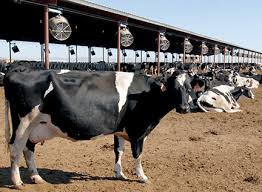Plan to boost milk production moves gear up
Smallholder farmers have received 153 in-calf heifers from the European Union in partnership with the Government and the Dairy Consortium, as part of efforts to rapidly increase milk production in Zimbabwe.
Presently, Zimbabwe is a major dairy importer.
The development comes as the number and contribution of smaller dairy farmers has significantly increased and is part of a growing effort to rapidly expand the dairy herd so that Zimbabwe can be self-supporting in dairy products.
The three largest sellers of milk and dairy products in Zimbabwe are major buyers of foreign currency on the Reserve Bank of Zimbabwe auction system to import bulk dairy products to fill the national demand.
The 153 in-calf heifers, which constitute the last batch of the 500 in-calf heifers imported from South Africa, is part of Transforming Zimbabwe’s Dairy Value Chain for the Future, a national dairy project under the Zimbabwe Agricultural Growth Programme that is expected to augment milk production to meet the targeted 130 million litres, up from 76 million litres produced last year.
The in-calf heifers project will run in all rural provinces and has so far seen 134 farmers, youths and women, benefiting.
The project is being championed by We Effect in partnership with the Zimbabwe Association of Dairy Farmers, Zimbabwe Farmers Union and Zimbabwe Dairy Farmers Association.
The €7 million project, which started in 2021, is expected to run until December next year.
It was targeting small-scale farmers inclusive of women and youths.
In a speech to mark the handover and distribution of heifers held in Mhondoro last Friday, Lands, Agriculture, Fisheries, Water and Rural Settlement Deputy Minister Vangelis Haritatos said the development was a testament of the Government’s commitment to revitalise the dairy sector.
“I would also want to commend the European Union and the Dairy Consortium partners for sponsoring and facilitating the importation of 500 in-calf dairy heifers in this project for the empowerment of the small-scale dairy farmers in Zimbabwe,” said Deputy Minister Haritatos.
“The dairy development project came at a time when the Government is promoting the revitalisation of the dairy sector through various growth initiatives as a strategy to improve milk quality and quantity in Zimbabwe.
“The heifers were distributed to 134 smallholder farmers in line with Government’ objective of inclusive value chain development strategy in the Agriculture and Food Systems Transforming Strategy.”
Deputy Minister Haritatos said the diary sector was an important sub-sector of agriculture contributing to food security and nutrition, employment in dairy value chain, export earnings and import substitution.
“The dairy sector has forward and backward linkages primary agriculture production, acting as a source of market for inputs such as stock feeds and feeds its products into the manufacturing sector, supplying various bi-products which are yoghurts, ice cream, fermented milk dairy juices and powdered milk,” he said.
Coordinator of the EU project, Dr Edson Chifamba, was critical of side-marketing by farmers and efforts were being made to trace this.
Side-marketing is whereby a farmer is selling milk in unregistered markets rather than delivering to their designated processor.
“We want to come up with proper statistics on the milk delivered to the processors, but the challenge is of side markets,” he said. “Farmers are selling milk outside the official channel on the side of roads.”
Zimbabwe Association of Dairy farmer’s national chairperson Mr Kudzai Chirima said side marketing emanated from low milk costs by processors and unaffordable prizes of stock feeds.
The geographical distance to the official markets poor road networks also discouraged farmers from delivering milk to far away places.-herald.cl.zw











